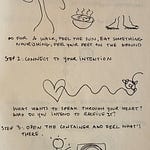Energetic leadership is the ability to say, “I’m going this way. Who’s coming with me?” Knowing where you’re going, what’s important to you, and having the courage and conviction to state it is no easy task. In my 7+ years leading Product Marketing teams at Meta, I developed a number of techniques that allowed me to stay true to who I am, no matter what was happening around me. This feels like a good time to share given the pressures that many companies and employees face, with the hope that this reminds you of your own techniques that work for you in your specific context.
I’ll break this into 9 steps, with more detail below. If you’d like to go deeper in this work with your team, I’m offering this content as an on-site workshop for groups of up to 40 people and as an asynchronous audio message exchange for individuals.
Ground yourself.
Say what you value.
Listen to the subtle data.
Treat meetings as spiritual gatherings.
Make people feel safe.
Embody your intentions.
Name the breakdowns.
Renegotiate.
Listen to your dreams – they’ll tell you when it’s time to go.
1. Ground yourself
When I say “ground,” I mean any practice that makes you feel heavy in your feet and centered in your body. The specifics of how you do this will be unique to you. For me, it’s spending time outside in fresh air, with my face in the sun. I would do this even in very small breaks between meetings when I worked on campus, and in my backyard when I worked from home. It’s cooking and eating nourishing food. It’s movement – yoga, hiking, dancing, anything that gets me connected with my body.
A grounding practice is important for staying true to your soul in a corporate context because your body is the instrument of your soul. Being present in your body enables you to be present with what’s going on around you, so that you can make choices about what to say and do that are aligned with who you are.
2. Say what you value
At Meta, we used Facebook Workplace (and before that, regular Facebook Groups) as our internal communications platform. I would regularly write posts about what was important to me, whether that was product priorities like making the hardware we were developing accessible to more people, or people priorities like my leadership team helping each other. No matter what else was going on, everyone I worked with knew what I stood for. I would reiterate those messages in All Hands. Communicating my values could also be more casual, like in one-on-ones and smaller meetings. I would always try to frame my values in the positive rather than the negative – it’s more helpful to say “we value abc” than “we don’t x or y” because the former gives more space for everyone to contribute to that goal in a generative way.
I did reach a point where my vision was not aligned with Meta’s vision, which is why I left. But up until that point, I found plenty of work to do that did align with what I cared about, including and most important, making the people I worked with feel cared for and able to do their best work.
3. Listen to the subtle data
Not all data comes on a spreadsheet. Reading my body’s own signals – where am I confused, uncomfortable, excited? – is critical for anchoring in my own orientation towards the situation. Reading body language and emotions from my colleagues is a massively important skill that allows me to move conversations and projects forward by asking questions about what isn’t being said. I hosted several leadership offsites at a horse farm, giving my teams the opportunity to observe and learn nonverbal communication cues from the horses and each other, and would regularly encourage them to tune into their own body’s data and read the room.
4. Treat meetings as spiritual gatherings
No, I’m not talking about lighting candles and burning sage (though that might be nice :). I’m talking about honoring each person in the meeting like they are souls showing up to do something important together, whether that's aligning on a roadmap or a sales strategy or how to position a status update to a leadership team or any other task. Tactically, this translated into making sure the agenda was clear and the objective of the meeting was concise, managing how we used the time in the meeting so that we achieved the objective, and respecting everyone’s presence by making space to listen. These are the basics of running a good meeting, but the intention I held for why we were meeting and how we were meeting was important. If I treated each meeting like a meeting of souls, my bar was higher for when a meeting needed to occur, and I held myself accountable for the quality of the meeting whether I was running it or not.
5. Make people feel safe
Sometimes this is as literal as saying to someone, “You are safe,” which I did in numerous one-on-ones. Often it is unstated but communicated by my own body language. If I feel safe, if my posture is aligned and relaxed, that sends a message that it’s ok for others to feel safe too. I remember a meeting I facilitated with six VPs across functions, all men, where I got us to break through a disagreement that had been holding back a team and product strategy. I did this by suggesting a framework for the meeting where each person would open with their thoughts and everyone else would listen and not interrupt, until each person had a chance to speak, and then we would move forward on specific areas of misalignment that had come up in the opening statements. This simple act of holding space for each of us to really listen to each other was transformative, because it broke the habit we were in of fighting and interrupting and created a sense of safety and assuredness that we would each be heard. (This is similar to a “talking stick” technique used in many indigenous and women’s circles and it worked just as well with male VPs over videoconference.)
6. Embody your intentions
This is another way of saying, “Follow through on your commitments.” If I say what I value and follow through on actions that put those values into the actual work, I am living in integrity. I may not be able to change the overall situation that’s happening, but I can do the work that’s in front of me, and people can trust that what I commit to, I will do. Sometimes it takes time to prove this out. For example, when I changed organizations from Meta’s Ads team to the hardware division (then called Facebook Reality Labs), it took time to establish credibility with my new team. I said I support women advancing in their careers, but it took several cycles to get the women who deserved promotions on my team promoted. I didn’t give up, even when they expressed frustration and skepticism of my commitment. Over time, we made progress, focusing on the work we could influence amid a larger system of entrenched patterns, not winning every battle but together in the fight.
7. Name the breakdowns
Asking questions like “What could get in the way of us fulfilling this commitment?” or stating observations like “You seem concerned about this plan” are examples of naming breakdowns. We might think of “breakdowns” as a negative thing, but as my former coach Heather Neely explained, recognizing that there’s a break in the flow from commitment to action allows you to deal with whatever is blocking you and your team. Embracing the “missing conversation,” as she called it, was a powerful tactic for being in your power and bringing others along with you by deeply listening and respecting their process and perspective.
8. Renegotiate
Renegotiating commitments is a transformative and underused tool that I learned to love. Part of living up to the commitments you make – embodying your intentions – is sensing when those commitments are unrealistic or just not the right actions to take right now, and being able to communicate that change with your stakeholders in a collaborative way.
9. Listen to your dreams – they’ll tell you when it’s time to leave
I knew for two years before I left Meta that I wanted to go, but it was a dream that told me it was time. If you have a practice of journaling your dreams (here’s a 9-minute listen on how to do it), they can be powerful indicators of what your subconscious or your higher self really wants.













Share this post